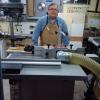Both Rockler and Woodcraft sell the same unit (different lables) of dust collector remote controls. They are available in either 110 or 220 volt.
I am on my second, 110 volt, Rockler unit rated for use up to 1 1/2 hp (no amps listed). I own a Delta 1/1/2 hp dust collector.
The female end of the plug in the remote units melt, and so far, have shorted out one of the two I have owned. I am expecting the second unit to also short out.
Is there a better unit on the market with a higher amp rating?






 Reply With Quote
Reply With Quote




